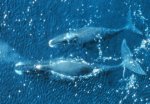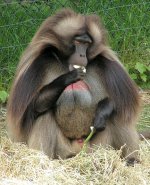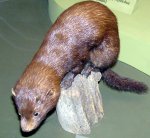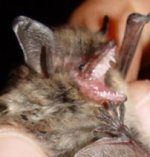Thursday 28 June 2007
Bowhead Whale

The
Bowhead Whale (Balaena mysticetus) is also named the Arctic Whale or Greenland Right Whale. Unlike other whales, the bowhead spends all its life in the Arctic waters. In history they were an ideal target for whale hunters, they are slow swimming and float after death. Their predators are orcas and humans. Depending on the location of the whales, they are classified as 'critically endangered' (Spitsbergen) to 'Lower risk - conservation dependent' (Bering-Chukchi-Beaufort).
Some facts:
- With their gigantic bony skulls they can break through 60 centimeter thick ice to breathe.
- The layer of blubber fat on their body can be as thick as 50 centimeters.
- Bowhead whales can stay as long as 40 minutes.
- Bowhead whales do not have dorsal fins and have the longest baleen plates of more then three meters.
You can help spreading the word about this animal by liking it on facebook
Permanent Link
Sunday 17 June 2007
Gelada

The
Gelada (Theropithecus gelada) can be found in the highlands of Ethiopia and Eritrea, the especially Semien Mountains National Park in Ethiopia. They are eaily recognizable for their hourglass-shaped patch on their chest. On males, the patch is surrounded by white hair. They live in small harems, consisting of one male, several females and the young Geladas. The small harems join together to feed and the numbers of the total number of Geladas can go as high as 670! The Gelada prefers to sleep on rocky cliffs. They are exclusively herbivorous and feed on grass, seeds, fruit, and flowers. Geladas are not listed as endangered, but it is estimated that around 50,000 to 60,000 exist today. Through habitat destruction and hunting they are forced to live more close to the Olive Baboon and hybiridsation has been observed.
Picture of the Gelada by sannse, licensed under GFDL
You can help spreading the word about this animal by liking it on facebook
Permanent Link
Friday 15 June 2007
American Mink

The
American Minks (Mustela vison) are considered as part of the Weasel Family, they are scattered over North America, but do not expect to find one at the tundra areas or Southwest US...unless of course, if somebody took it for a pet and brought it there. I am speaking about the American Mink, and akin to many other weasels, they have a similar physique. Usually, one weighs 2.07 kg, and the males are usually bigger than the female side. The color of the American Minks' hair range from brown to something very close to black, but the underside has a lighter shade. An American Mink's soft, thick fur gives warmth and protection when in they are in aquatic places. They are nocturnal, active the whole year long, and are outstanding swimmers. In the treacherous world of animals, they are fair game for coyotes, foxes, bobcats and even owls (yes, owls, believe it or not).
Creatures usually at the shorelines serve as the American Mink's basic food requirements, such as muskrats, shrews, various fish, frogs, salamanders, earthworms and insects. They ordinarily live in burrow (roots of trees) or shelters created by beavers. The males journey more than the distaff side, and they utilize many of the said places. According to records, at the UK mainland, these Minks survive on rats and rabbits. When winter comes, the fish would serve as their staple food, as many kinds of fish become torpid. Minks would kill a greater number of birds than what they actually need to eat, and they would conserve the surplus. Regarding mating, the males are known to be promiscuous, and the later the period of mating, the shorter implantation period is. Newborns are all of the following: wrinkled, pink, blind and deaf. An American Mink would be able to take care of itself at 2 months old.
Interesting fact: It has been known that they have the capability to kill snakes, but... they do not seem to eat them.
You can help spreading the word about this animal by liking it on facebook
Permanent Link
Monday 11 June 2007
Lemurine night monkey
The
Lemurine night monkey (
Aotus lemurinus) can be found in Central and South America, from Panama to Norht-east Argentina and from Peru to Brazil. They prefer the dense forest with many vines and live in several canopy levels, moving around quadrupedally (with both legs and arms) and only occasionaly touch the ground. Lemurine night monkeys are nocturnal animals and live in groups of 2 to 5 members (one mating, monogamous, pair and their offspring). Female and males look alike and even both take care of their young.
You can help spreading the word about this animal by liking it on facebook
Permanent Link
Monday 04 June 2007
Whiskered bat

The
Whiskered bat (
Myotis mystacinus) lives mostly in central Europe and is small, has a pointy face and short pointed ears and has shaggy fur. It is darker than the Brandt's bat, which looks very similair and could easily be confused with. They can become 4 to 8 grams in weight and reach 24 years of age, but the average is 4 years old. Their diet consists of gnats, mayfly, moths, flies and mosquitoes.
Links
World Deer
Animal Diversity Web
Photo of the whiskered bat
Picture by Mnolf, licensed under GFDL.
You can help spreading the word about this animal by liking it on facebook
Permanent Link
 The Bowhead Whale (Balaena mysticetus) is also named the Arctic Whale or Greenland Right Whale. Unlike other whales, the bowhead spends all its life in the Arctic waters. In history they were an ideal target for whale hunters, they are slow swimming and float after death. Their predators are orcas and humans. Depending on the location of the whales, they are classified as 'critically endangered' (Spitsbergen) to 'Lower risk - conservation dependent' (Bering-Chukchi-Beaufort).
The Bowhead Whale (Balaena mysticetus) is also named the Arctic Whale or Greenland Right Whale. Unlike other whales, the bowhead spends all its life in the Arctic waters. In history they were an ideal target for whale hunters, they are slow swimming and float after death. Their predators are orcas and humans. Depending on the location of the whales, they are classified as 'critically endangered' (Spitsbergen) to 'Lower risk - conservation dependent' (Bering-Chukchi-Beaufort). 
 The
The  The
The  The
The